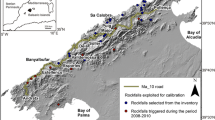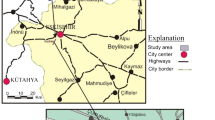Abstract
The Lengpui-Aizawl highway in the Northeastern part of India has witnessed several rockfall events in the past decades. This is the only highway that connects the Airport to the city. Considering the importance of the highway, semi-empirical equations were developed to predict the rockfall output parameters such as bounce height, velocity and kinetic energy. The five major input parameters, such as slope height, slope-angle, slope-roughness, block-weight and coefficient of restitution that can affect the rockfall, have been considered for the parametric study. The paper includes detailed site investigation, laboratory investigation and rockfall modelling to estimate the generalised equations based on multivariate linear regression analysis. The site survey includes topographical and geological details of 13 rock slopes along the Lengpui-Aizawl highway. The coefficient of restitution was estimated in the laboratory using a fabricated rockfall setup. Further, 243 modellings were performed to analyse the data and develop the generalised rockfall equations. These generalised equations will help the field engineers to predict the outcome of the rockfall activity and help design suitable mitigative measures.














Similar content being viewed by others
Data Availability
Enquiries about data availability should be directed to the authors.
References
Asteriou P (2019) Effect of impact angle and rotational motion of spherical blocks on the coefficients of restitution for rockfalls. Geotech Geol Eng 37(4):2523–2533
Asteriou P, Saroglou H, Tsiambaos G (2012) Geotechnical and kinematic parameters affecting the coefficients of restitution for rock fall analysis. Int J Rock Mech Min Sci 2012(54):103–113. https://doi.org/10.1016/j.ijrmms.2012.05.029
Badger T, Lowell S (1992) Rockfall control in Washington State. Transportation Research Record 1343, National Academy of Sciences, Washington, pp 14–19
Buzzi O, Giacomini A, Spadari M (2012) Laboratory investigation on high values of restitution coefficients. Rock Mech Rock Eng 45(1):35–43. https://doi.org/10.1007/s00603-011-0183-0
Dattola G, Crosta GB, di Prisco C (2021) Investigating the influence of block rotation and shape on the impact process. Int J Rock Mech Min Sci 147:104867
Ganju JL (1975) Geology of Mizoram. Bull Geol Min Met Soc India 48:17–26
Hoek E, Bray JW (1981) Rock slope engineering, 3rd edn. Institute of Mining and Metallurgy, London
Hoek E (1999) Putting numbers to geology - An engineer’s viewpoint. Felsbau 17(3):139–151
Irfan M, Chen Y (2017) Segmented loop algorithm of theoretical calculation of trajectory of rockfall. Geotech Geol Eng 35(1):377–384
ISRM (1981) Suggested methods: rock characterization, testing and monitoring. ISRM Commission on Testing Methods Pergamon, Oxford
Jaswal M, Sinha RK, Sen P (2020) Delineation of phreatic surface in soil type slope—a comparative study using physical and numerical modeling. J Min Sci 56(3):494–504. https://doi.org/10.1134/S1062739120036787
Kesari GK (2011) Geology and mineral resources of Manipur, Mizoram, Nagaland and Tripura. Geological Survey of India, Government of India, Guwahati, pp 1–103.
Kumar N, Verma AK, Sardana S, Sarkar K, Singh TN (2018) Comparative analysis of limit equilibrium and numerical methods for prediction of a landslide. Bull Eng Geol Env 77(2):595–608. https://doi.org/10.1007/s10064-017-1183-4
Lallianthanga RK, Lalbiakmawia F, Lalramchuana F (2013) Landslide hazard zonation of Mamit Town, Mizoram, India using remote sensing and gis techniques. Int J Geol Earth Environ Sci 3(1):184–194
McCarroll D, Shakesby R, Matthews J (1998) Spatial and temporal patterns of late Holocene rockfall activity on a Norwegian talus slope: a lichenometric and simulation-modeling approach. Arctic Alpine Res 30:51–60
McColl S (2015) Landslide causes and triggers. In landslide hazards risks and disasters. Academic Press, pp 17–42
Montgomery DC, Runger GC, Hubele NF (2011) Engineering statistics, 5th edn. Wiley, USA
Peila D, Ronco C (2009) Technical Note: Design of rockfall net fences and the new ETAG 027 European guideline. Nat Hazards Earth Syst Sci 9(4):1291–1298. https://doi.org/10.5194/nhess-9-1291-2009
Peng B (2000) Rockfall trajectory analysis - parameter determination and application. Civil Engineering, June.
Ram J, Venkataraman B (1984) Tectonic framework and hydrocarbon prospects of Mizoram. Petrol Asia J 7(1):60–65
Richards L (1988) Rockfall protection: a review of current analytical and design methods. Secondo Ciclo Di Conferenze Di Meccanica Ed Ingegneria Delle Rocce, MIR, Politecnico Di Torino, 11:1–13
Ritchie AM (1963) Evaluation of rockfall and its control. In Highway Research Record 17, Stability of Rock Slopes, Highway Research Board, National Research Council, Washington, pp 13–28.
RocScience (2016) Statistical analysis of rockfalls: collision analysis verification manual. RocScience Inc., Toronto
Roth RA (1983) Factors affecting landslide-susceptibility in San Mateo county, California. Bull Assoc Eng Geol 20(4):353–372
Sardana S, Verma AK, Singh A, Laldinpuia. (2019a) Comparative analysis of rockmass characterization techniques for the stability prediction of road cut slopes along NH-44A, Mizoram, India. Bull Eng Geol Env 78(8):5977–5989. https://doi.org/10.1007/s10064-019-01493-3
Sardana S, Verma AK, Verma R, Singh TN (2019b) Rock slope stability along road cut of Kulikawn to Saikhamakawn of Aizawl, Mizoram India. Nat Hazards 99(2):753–767. https://doi.org/10.1007/s11069-019-03772-4
Sardana S, Sharma P, Verma AK, Singh TN (2020) A case study on the rockfall assessment and stability analysis along Lengpui-Aizawl highway, Mizoram India. Arab J Geosci. https://doi.org/10.1007/s12517-020-06196-8
Sinha R (2013) Influence of in situ stress on design of layout and support in bord and pillar workings. Thesis, Indian School of Mines, India
Srikanth M (2015) Analysis of rockfall trajectories and evaluation of concrete.
Valagussa A, Frattini P, Crosta GB (2014) Earthquake-induced rockfall hazard zoning. Eng Geol 182(PB):213–225
Verma AK, Sardana S, Singh TN, Kumar N (2018) Rockfall analysis and optimized design of rockfall barrier along a strategic road near Solang Valley, Himachal Pradesh India. Indian Geotech J 48(4):686–699. https://doi.org/10.1007/s40098-018-0330-6
Verma AK, Sardana S, Sharma P, Dinpuia L, Singh TN (2019) Investigation of rockfall-prone road cut slope near Lengpui Airport, Mizoram, India. J Rock Mech Geotech Eng 11(1):146–158. https://doi.org/10.1016/j.jrmge.2018.07.007
Verma AK, Sinha RK, Sardana S, Jaswal M, Singh TN (2021) Investigation into the rockfall hazard along Lengpui-Aizawl Highway, NH-44A, Mizoram, India. Indian Geotech J 1:98
Vogel T, Labiouse V, Masuya H (2009) Rockfall protection as an integral task. Struct Eng Int: J Int Assoc Bridge Struct Eng (IABSE) 19(3):304–312. https://doi.org/10.2749/101686609788957856
Wei LW, Chen H, Lee CF, Huang WK, Lin ML, Chi CC, Lin HH (2014) The mechanism of rockfall disaster: a case study from Badouzih, Keelung, in northern Taiwan. Eng Geol 183:116–126. https://doi.org/10.1016/j.enggeo.2014.10.008
Wu S (1985) Rockfall evaluation by computer simulation. Transportation Research Record, No.1031, pp 1–5
Wyllie D, Norrish N (1996) Stabilisation of rock slopes. In landslides: investigation and mitigation, transportation research board, national research council, special report, 247(474):500
Acknowledgements
The authors would like to thank the Ministry of Earth Science (MOES), Government of India, for the grant to carry out this study. The concerned personnel of various departments in IIT(ISM) Dhanbad are highly acknowledged.
Author information
Authors and Affiliations
Corresponding author
Ethics declarations
Conflicts of Interest
The authors wish to confirm that there are no conflicts of interest with this research article.
Additional information
Publisher's Note
Springer Nature remains neutral with regard to jurisdictional claims in published maps and institutional affiliations.
Rights and permissions
About this article
Cite this article
Sardana, S., Sinha, R.K., Verma, A.K. et al. A Semi-Empirical Approach for Rockfall Prediction Along the Lengpui-Aizawl Highway Mizoram, India. Geotech Geol Eng 40, 5507–5525 (2022). https://doi.org/10.1007/s10706-022-02229-z
Received:
Accepted:
Published:
Issue Date:
DOI: https://doi.org/10.1007/s10706-022-02229-z




